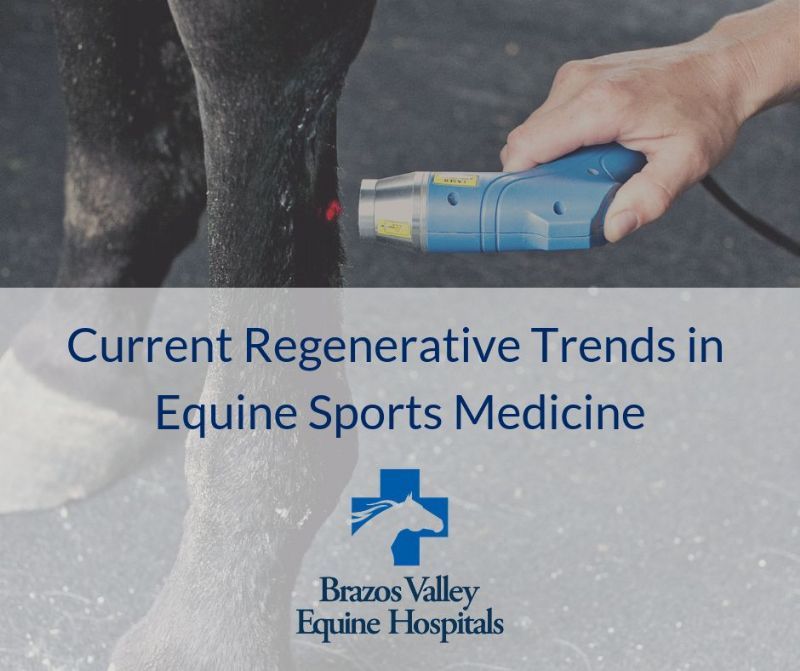
In this article by our very own Dr. John Janicek, DVM, MS, DACVS, will focus exclusively on rapidly evolving treatment options and less invasive solutions, such as regenerative therapies.
Injuries & Athletes
Musculoskeletal injuries are common in elite and weekend equine athletes.
Tendonopathies of the superficial or deep digital flexor tendon (bowed tendons), suspensory ligament or inferior check ligament desmopathies (strains or tears), collateral ligament desmopathies, and joint injuries/osteoarthritis are common problems of horses that can be difficult to treat. Traditional approaches to tendonopathies and desmopathies include therapies such as icing and bandaging; whereas hyaluronic acid and corticosteroids have traditionally been used to manage joint injuries and osteoarthritis. While such methods of treatment are valuable, they do not focus on improving the cellular response to injury.
PRP
Platelet-rich plasma (PRP) has emerged as a valuable solution. PRP is exactly what its name suggests; the substance is a by-product of blood that is rich in platelets, growth factors, and proteins. PRP is considered a point- of-care treatment option; meaning the blood can be processed and infused back into the horse within 20 minutes. The rationale for the use of PRP in the treatment of tendonopathies and desmopathies arises from the combination of growth factors released from platelets at the site of injury. Two additional incentives for using PRP in tendon and ligament repair include its availability and that it will not be rejected by the patient’s immune system.
Stem Cells
Stem cells have attracted considerable interest because of their potential to mediate the formation of new tissue matrix. Mesenchymal stem cells are most commonly derived from the patient’s bone marrow or fat and are thought to be pluripotent…meaning they are able to differentiate into cartilage, bone, tendon, and ligaments. Fat or bone marrow is harvested from the horse, sent to appropriate labs for isolation or stem cell culturing, sent back to the hospital, and injected into the injured tissue or joint.
Bone Marrow
Bone marrow aspirate concentrate (BMAC) is a regenerative therapy that contains platelets and stem cells to help accelerate healing in moderate tendon or ligament injuries and severe osteoarthritis.
BMAC is a point-of-care therapy that is performed by aspirating bone marrow from the horse, processing the BMAC, and infusing the BMAC into the injured tissue within 20 minutes. While similar to PRP in its ability to control the body’s ability to heal itself through the aid of growth factors, BMAC utilizes pluripotent stem cells that are contained within a patient’s own bone marrow.
Interleukin-1 Receptor Antagonist
IRAP
Protein (IRAP) is an effective intra-articular treatment for joint disease. IRAP has the potential to slow the cartilage matrix from being degraded, increase the healing process within the joint, and provide a safe, long-term solution to battling joint disease.
IRAP has the ability to effectively stop joint inflammation without the side effects of corticosteroids. This treatment modality utilizes the patient’s blood, which is transferred into a special syringe containing glass beads; the blood is incubated for 18-24 hours, processed, and the IRAP protein rich serum is separated into 3-4 ml doses which can be frozen for later use.
Pro-Stride
Pro-Stride Autologous Protein Solution is a natural, drug free, point- of-care regenerative medicine treatment option for joint disease.
Pro-Stride is a device whose output yields a concentrated solution of cells, platelets, growth factors, and natural anti-inflammatory proteins. Simply put, this treatment option is a combination of PRP and IRAP in one single syringe. Pro-Stride has proven to reduce pain associated with arthritis, slow the cartilage from being degraded, improvement in lameness up to one-year, and increased joint range of motion. To have this procedure performed, blood is obtained from your horse, processed within the clinic, and infused back into your horses joint within 20 minutes.
One Goal. Many Options.
Many regenerative therapeutic options are currently available to enhance the healing response on a cellular and molecular level which can ultimately improve the quality of repair, improve the prognosis for return to performance, and decrease the incidence of re-injury of your equine athlete.
The hard part is up to the veterinarian to determine which modality is best suited for each individual horse and then, for you as the owner, to be patient enough and allow these regenerative treatment options to help get you and your horse back on the road to success.
If you have any questions about respiratory issues, please contact us.
